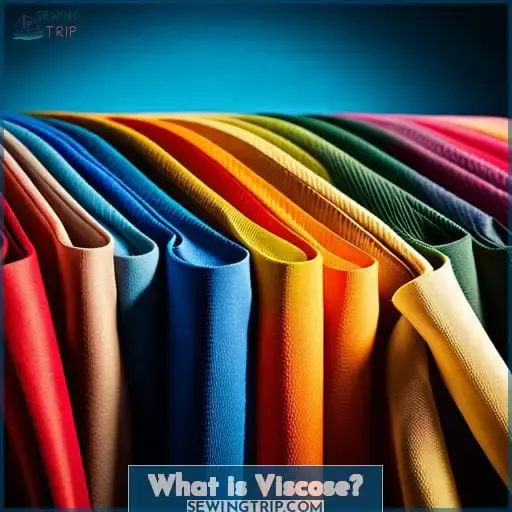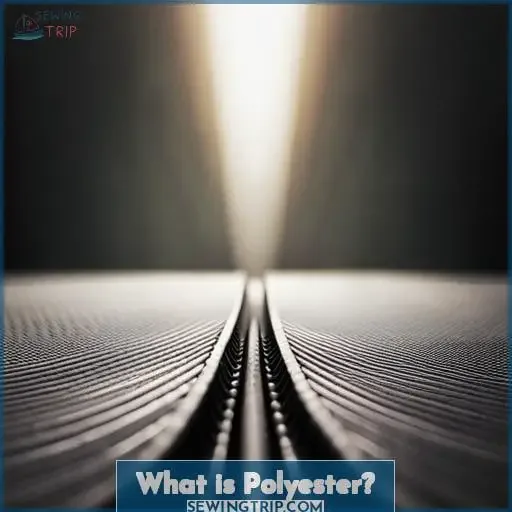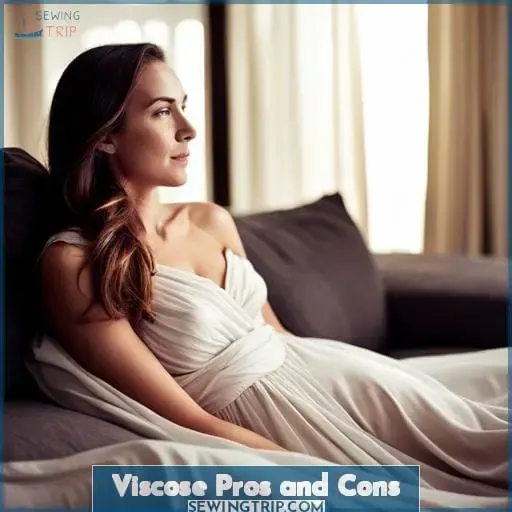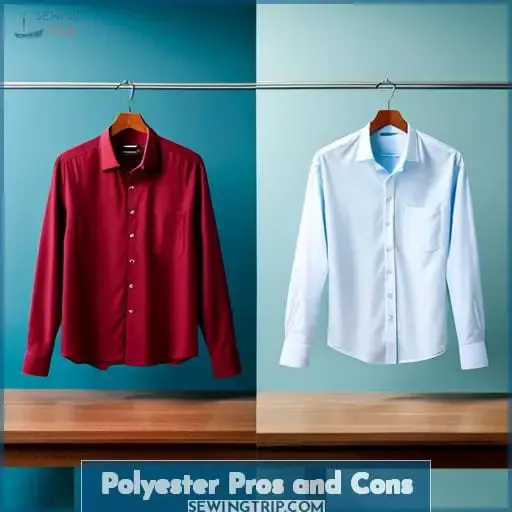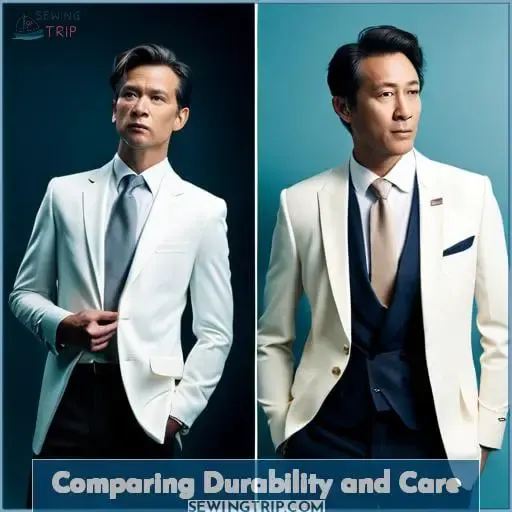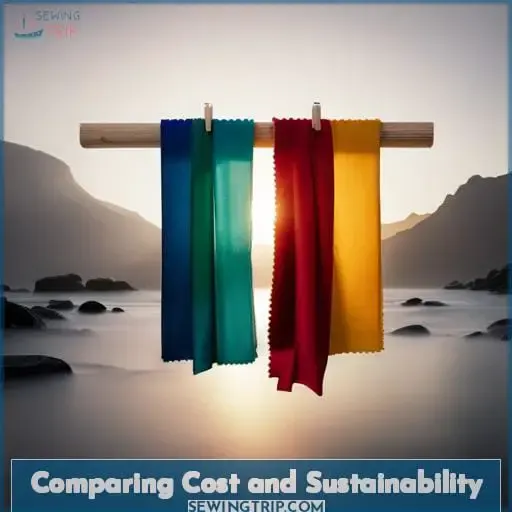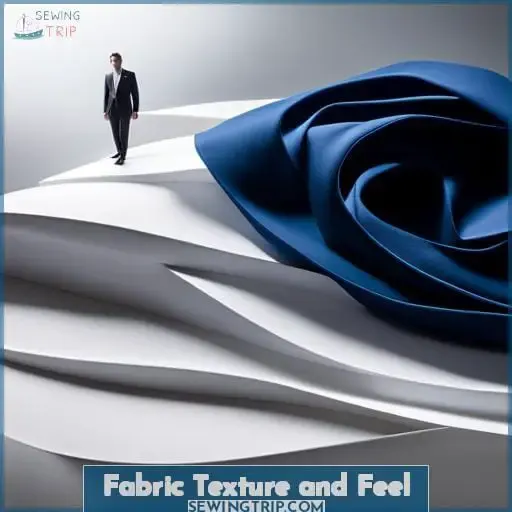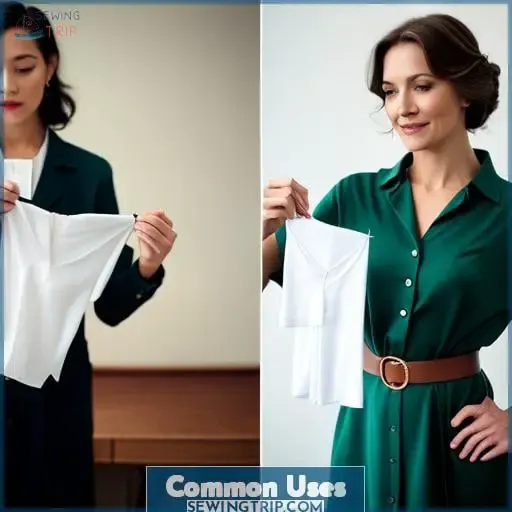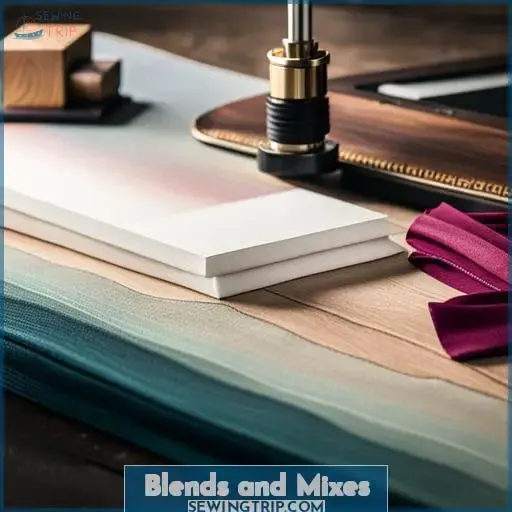This site is supported by our readers. We may earn a commission, at no cost to you, if you purchase through links.
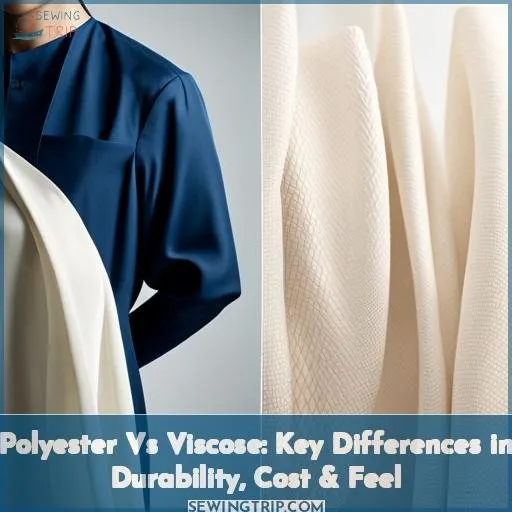 You, being the fashion forward textile engineer you are, know fabric. But do your fibers flummox you?
You, being the fashion forward textile engineer you are, know fabric. But do your fibers flummox you?
Polyester – it’s for activewear.
Viscose – it’s for flowy dresses.
But what else sets these staples of style apart? Get ready to become a fiber fanatic and explore the features that distinguish polyester from viscose.
We’ll plunge deep into durability, cost, feel and more. You’ll get the full fabric fandango on how these fibers differ in their:
- Breathability
- Absorbency
- Sustainability
By the end, your fashion knowledge will be fit to burst! Whether you’re picking an outfit or pondering fabric for your clothing line, you’ll gain key insights to make informed choices between polyester and viscose.
Let’s dive in – your fiber education starts now!
Table Of Contents
Key Takeaways
- Polyester is more durable and wrinkle-resistant, while viscose wrinkles easily and loses shape over time.
- Viscose has a softer, silkier feel on skin compared to the smoother synthetic feel of polyester.
- Polyester retains odors more, while viscose is more breathable.
- Polyester is generally cheaper to produce, while viscose is more eco-friendly, though has pollution concerns in production.
What is Viscose?
You’re probably familiar with viscose as that silky, lightweight fabric your favorite dress or blouse is made from. Viscose begins life as purified cellulose from wood pulp or bamboo. Through a series of chemical processes, the cellulose is transformed into a soluble compound and extruded through spinnerets to form soft, lustrous viscose fibers.
As a regenerated cellulosic fiber, viscose is highly absorbent, breathable, and exceptionally smooth against the skin. It drapes beautifully and takes dye exceptionally well, resulting in rich, long-lasting color.
Viscose also blends wonderfully with other natural fibers like cotton and wool as well as synthetics like polyester.
However, viscose lacks the resilience and durability of fully synthetic fabrics. It wrinkles easily, is prone to shrinking and pilling, and loses its shape over time. Viscose garments require gentle washing and air drying to maintain their beauty.
While not as strong as polyester, viscose offers comfort and luxury at an affordable price point. Its renewability and biodegradability also give it an edge over synthetics in sustainability. For those qualities that make it irresistible next to skin, viscose continues to be a popular choice despite requiring a bit more care.
What is Polyester?
Let’s avoid non-renewable fabrics that trap heat and dampen our spirits. Discover the breathable comfort of viscose instead.
Polyester is a synthetic fabric made from petroleum-derived polymers. The most common type is polyethylene terephthalate, or PET polyester. Polyester fibers are extruded under high heat and pressure, then spun into yarns used to weave or knit polyester textiles.
While appreciated for its durability, polyester has faced criticism for lacking breathability. Its nonporous fibers trap heat and moisture against the skin. However, polyester wicks perspiration outward to evaporate from the surface.
New moisture management polyesters aid cooling. Still, polyester can’t match the comfort and absorbency of natural fibers like viscose rayon.
As the world moves away from fossil fuels, petroleum-based synthetics lose appeal. Polyester production consumes significant energy and emits greenhouse gases. It also generates large amounts of wastewater.
While polyester dominates performance fabrics, viscose leads in fashion. Viscose drapes luxuriously, retaining its dye and shape through gentle washings. As consumers embrace sustainability, eco-friendly viscose offers an alluring natural alternative to heat-trapping polyester.
Viscose Pros and Cons
Viscose’s supple luster caresses your form in fluid, waterfall drapes. However, its refinement comes at a price, as delicate viscose wrinkles with a touch and shrinks from heat.
Soft, Drapes Well
The viscose caresses your skin softly as it drapes delicately around your body.
- Feels light as a breeze against the skin
- Drapes smoothly over every curve
- Flows gracefully with your movements
- Sensual silkiness that delights the senses
Choose viscose for its sublimely soft and fluid feel. Feel the difference from stiff, plastic polyesters trapping heat against you. Let viscose breathe cool comfort next to your skin. Revel in viscose’s featherweight drape as it flows gracefully with your every motion.
Discover why viscose is the favored natural choice for sensuous lingerie and diaphanous dresses.
Wrinkles Easily, Prone to Shrinking
Your viscose dress shrivels disappointingly after just one spin in the dryer. The delicate fibers warp and weave haphazardly as the heat saturates its flimsy frame. Fragile filaments fray as stitches stretch and distort. Ripples cascade through sheer fabrics while supple shapes sag.
That diaphanous drape you adored now hangs limp and loose. Slender seams strain as your dress deflates from its billowy silhouette into a shrunken sack.
Choose sturdier synthetics next time. Polyesters maintain their molded magnificence even when manhandled. There’s no need to tiptoe around timid textiles when hardy fabrics stand ready to serve. Let synthetics free you from handle-with-care wardrobes. Embrace low-maintenance living so clothes care for themselves.
Polyester Pros and Cons
Polyester is known for its durability and wrinkle resistance; it will maintain its shape through many washings and wearings. However, polyester is not very breathable. It can trap heat and moisture against your skin, leading to discomfort.
The nonporous fibers don’t allow perspiration to escape, so polyester may make you overheat. But if easy care and minimal ironing are your priorities, polyester’s resilience and washability make it a go-to choice.
Durable, Wrinkle Resistant
Unyielding polyester cradles you in its firm embrace, never releasing its grasp. The resilient fibers bend but never break, retaining their shape wash after wash. Polyester’s polymer backbone laughs in the face of wrinkles, the fibers bouncing back to smooth perfection.
Moisture rolls right off the hydrophobic fibers, wicked to the surface where it evaporates in a flash. While viscose clings with a gentle touch, polyester holds fast with an iron grip. The synthetic fibers remain steadfast and true long after fickle viscose has shrunk and stretched into misshapen oblivion.
Polyester’s durability and wrinkle resistance give you the freedom to move through life unfettered by garments out of shape. Its reliability means one less worry, so you can focus on unlocking your potential.
Polyester frees you to pursue your purpose with confidence its enduring fibers will neither bind nor fail you.
Not Breathable, Traps Heat
You’re cooked in polyester’s sweltering embrace, sweat pooling as the unbreathable fibers block airflow. The synthetic polymer chains bond tightly, leaving no room for your skin to breathe. Trapped between skin and polyester, perspiration permeates while air cannot circulate.
Polyester’s impressive durability comes at the cost of breathability. Unlike viscose’s porous structure, polyester is dense and impermeable.
Yet polyester is invaluable for sweatshirt linings, cushioned footbeds, upholstery stuffing, and thermal underwear. While excellent for durable, warm fabrics, polyester strips cool airflow. Still, innovative finishes now allow more breathable, moisture-wicking polyester to keep you dry and comfortable.
Though it may run hot, polyester’s fortitude shelters you like a cocoon. You can rely on its resilient embrace in any weather.
Comparing Durability and Care
As a textile engineer, I understand the importance of fabric durability and care requirements. Polyester is significantly more durable than viscose and better maintains its shape through repeated laundering.
However, viscose requires much gentler care – hand washing in cool water and line drying to prevent shrinking. Polyester’s resilience allows machine washing and drying on low heat. When choosing between polyester and viscose, one should consider their differing levels of durability and necessary care.
Polyester More Durable
When clad in polyester, its unbending nature shields you from rips and snags compared to flimsy viscose.
The durable fibers of polyester offer:
- Wrinkle recovery to resist permanent creasing.
- Stain resistance to repel spills and stains.
- Abrasion resilience to withstand rubbing and friction.
- Shape retention even after repeated wear and washing.
Polyester demonstrates impressive chemical durability compared to delicate viscose rayon. The polymer chains of polyester fibers provide strength and structure that prevent stretching and distortion over time.
Instead of sagging out of shape, polyester fabric retains a crisp silhouette thanks to the tenacity of these synthesized fibers. So choose polyester when you need a fabric tough enough to endure daily activities without accumulating damage.
Viscose Requires Gentler Care
Viscose requires gentler care. You end up delicately hand washing your viscose clothes in cold water to preserve their shape and softness. The supple drapes and luxurious feel of viscose come at a price – without diligent care, this fabric loses its splendor.
Viscose puckers and pills easily when machine washed or dried, unlike durable polyester. To keep viscose smooth and vibrant, treat it gently. Hand wash in cool water with a mild detergent, never wringing or twisting the garment.
Air dry viscose flat to prevent stretching; a clothesline or drying rack allows gravity to preserve the drape and shape. While polyester stands up to repeated wearing and washing, delicate viscose requires a personal touch – your tender loving care – to retain its beauty.
Comparing Cost and Sustainability
As a textile engineer, I appreciate how comparing costs and sustainability helps decide between viscose and polyester fabrics. While polyester is usually less expensive to manufacture, viscose is more eco-friendly since it derives from renewable plant cellulose rather than non-renewable petroleum.
However, polyester production utilizes fewer chemicals than viscose rayon processing does. When selecting fabrics, one must carefully weigh cost savings versus sustainability impacts.
Polyester Generally Cheaper
Look, the realization hits hard that polyester’s usually more economical even though viscose is more sustainable. Made from petrochemicals, polyester benefits from an established infrastructure and prolific manufacturing, allowing vast volume and affordable pricing.
Its versatility suits everything from workout gear to home textiles, maximizing use from each gallon of oil. With exceptional durability from interlinked polymer chains, polyester endures the rigors of daily life and laundering.
Viscose’s plant-based origins provide abundance, but its delicate nature necessitates cautious handling. Without polyester’s chemical fortitude, viscose lacks comparable tensile strength and shape retention.
However, innovations in eco-friendly production and intelligent blends with sturdier fibers help viscose gain ground.
As technology progresses, sustainability and affordability needn’t be mutually exclusive.
Viscose More Sustainable
You’d think viscose wins on sustainability, but it’s a mixed bag. Derived from renewable plant cellulose like bamboo or eucalyptus wood pulp, viscose seems eco-friendly. However, extensive chemical processing harms workers and environments when not carefully controlled.
Raw material sourcing and manufacturing practices require scrutiny. While moisture-retentive, viscose easily accepts dyes but lacks cotton’s inherent strength or polyester’s tenacity. Still, as a regenerated cellulose, viscose aligns with consumer desire for safe, natural fibers.
With industry transparency and improved practices, viscose production can become sustainable, meeting demand for reasonably-priced, versatile plant-based textiles.
Fabric Texture and Feel
As a textile designer, I appreciate the key differences in texture and feel between polyester and viscose fabrics. Viscose has a soft, cool, silk-like hand that feels luxurious against the skin. In contrast, polyester’s smooth, synthetic feel suits sportier, more casual attire.
When selecting fabrics for apparel, these tactile distinctions help determine appropriate uses.
Viscose Soft, Cool, Silk-like
Unlike polyester, viscose fabric feels incredibly soft and silky against your skin thanks to its breathable, moisture-absorbing rayon fibers that provide a cooler, more luxurious hand.
The three qualities that make viscose stand out are:
- Light and flowing drape that elegantly conforms to the contours of the body.
- Cool, refined feel reminiscent of silk that is pleasing against bare skin.
- Delicate texture with a refined luster that gives viscose its signature grace and elegance.
The luxurious softness and delicate drape of viscose evoke images of flowing gowns and feminine blouses, making it a refined choice for formalwear and special occasion pieces where comfort and elegance take priority over durability.
Though more high maintenance than polyester, viscose’s silk-like sheen and supple hand impart a touch of luxury.
Polyester Smooth, Synthetic Feel
You’ll find polyester has a smooth, synthetic feel against your skin. The sleek polyester fibers don’t breathe like natural fabrics do. This trait gives polyester garments a clinging, almost plastic-like hand that lacks the comfort and drape of viscose.
Polyester’s non-absorbent synthetic fibers can’t replicate viscose’s soft, cool luxury. But the synthetic fabric does excel at moisture wicking. So while a viscose blouse gracefully drapes against you, a polyester athletic top will slickly whisk away sweat.
The synthetic fibre keeps you dry though it may sometimes feel oddly slick and plastic-smooth.
Polyester’s synthetic feel suits its specialty: durable, wrinkle-resistant, machine-washable clothing that retains its shape despite repeated wear and washing.
Absorbency and Breathability
As a fabric designer, you know viscose and polyester have distinct absorbency and breathability profiles. Viscose is more absorbent, readily taking in moisture, while polyester’s hydrophobic structure blocks absorption.
With low breathability, polyester also traps heat and sweat next to skin. Understanding these divergent properties helps select the right fabric for an item’s function and comfort.
Viscose More Absorbent
Polyester’s slick finish repels moisture, yet viscose readily soaks up perspiration.
- Enhanced moisture absorption
- Improved perspiration dissipation
- Exceptional sweat diffusion
- Advanced evaporation of sweat
- Maximized evaporation kinetics of perspiration
The smooth hydrophobic surface of polyester pushes moisture away, while viscose’s absorbent fibers actively pull in sweat. This remarkable moisture management makes viscose the perfect choice for athletic and workout attire that needs to breathe and stay dry during activity.
Although polyester resists dampness, viscose’s unparalleled absorbency keeps you cool, dry and comfortable all day long.
Polyester Doesn’t Breathe
Wow, viscose lets your skin breathe so freely, it’s like you’re wearing nothing at all! Polyester’s nonporous surface seals in heat and sweat.
| Polyester | Viscose |
|---|---|
| Non-breathable | Excellent breathability |
| Traps heat/moisture | Absorbs moisture |
| Causes overheating | Keeps you cool |
| Retains odors | Reduces odor retention |
Viscose’s breathability comes from its absorbent plant-based fibers that draw in moisture. The pores in viscose fabrics allow airflow next to your skin. This sweat-wicking performance prevents the hot, irritating buildup caused by polyester’s impermeable structure.
Common Uses
As a textile engineer and fashion journalist, you know these two very different fabrics have become staples in the clothing industry. While polyester dominates performance wear like activewear, where its durability and wicking properties are ideal, viscose has carved out a niche in women’s fashion with its soft drape and feel lending elegance to dresses, blouses, and lingerie.
With their divergent qualities, polyester and viscose each excel in their distinct domains.
Polyester for Activewear
You’re picking polyester for activewear as it wicks sweat and dries fast. The synthetic fiber’s lack of absorbency keeps perspiration from weighing down a garment during exercise. By wicking moisture from the body to the fabric surface, polyester’s hydrophobic structure moves sweat away for quick evaporation.
This is crucial for performance apparel, allowing skin to stay dry during activity.
Polyester shapes retain fit from the first wear to the fiftieth wash – important for support garments. The fiber’s inherent stretch and recovery enables flexibility and ease of movement. Though less breathable than natural textiles, polyester’s durability and efficient moisture control makes it ideal for high-intensity athletics.
For vigorous workouts and competitive sports, polyester activewear supports exercise, resists odor, and enhances comfort through sweat management and durable stretch.
Viscose for Dresses and Blouses
You’ll love viscose’s soft drape for dresses and blouses. The semi-synthetic fabric elegantly skims curves with a flowing, lightweight feel. Absorbing moisture, viscose keeps skin cool in warm weather. With viscose’s soft hand against the skin and ability to follow body contours, it excels in feminine garments.
The fabric’s liquid-like drape flatters figures by elegantly draping without cling. Though prone to wrinkling, viscose takes shape again with steaming. Avoid agitation and heat when laundering to prevent shrinkage.
For a softly draping fabric with beautiful movement, viscose is ideal for dresses, blouses, and other garments worn close to the skin.
Blends and Mixes
Though polyester and viscose have their strengths, designers often blend them to get the best of both worlds in comfort, drape, and ease of care. As a textile engineer, I often recommend fabric blends to balance the pros and cons of each fiber.
Polyester and viscose seem unlikely partners, but their contrasting properties can complement each other well when blended. Polyester brings durability, shape retention, and wrinkle resistance while viscose lends softness, absorbency, and beautiful drape.
Blending them allows the fabric to breathe better, drape elegantly, and retain its shape through wearing and washing.
The right blend balances thermoregulation, absorbency, and wrinkle resistance while being reasonably priced and sustainable. Adjusting the ratio of polyester and viscose fibers optimizes the fabric’s performance for its end use, whether everyday wear, activewear, or formalwear.
A 65/35 polyester/viscose blend could offer both comfort and easy care, for example. Going with woven or knitted constructions further fine-tunes the texture, feel and drape.
When blended strategically, these very different fibers play well together. Polyester provides structure while viscose adds softness. The result is a fabric that looks great, feels amazing, and holds up over time. With both natural and synthetic origins, the combo also balances sustainability impact and price.
Finding the sweet spot between performance, comfort and care is the art of blending.
Frequently Asked Questions (FAQs)
How do polyester and viscose fabrics feel against the skin? Which is softer?
Viscose feels like a soft caress against your skin, while polyester is stiff and scratchy. Viscose drapes fluidly as you move, almost liquid-like. Polyester clings awkwardly. The plant-based viscose fibers are gentler on sensitive skin; synthetic polyester can chafe and irritate.
What types of clothing and apparel are polyester and viscose best suited for?
Polyester is ideal for activewear that needs to wick moisture and retain its shape. Look to viscose for lightweight dresses and blouses with beautiful drape and softness against the skin.
How do polyester and viscose fabrics hold up over time after repeated wearing and washing? Which lasts longer?
After repeated wearings and washings, polyester fabrics will outlast viscose. Polyester’s durable fibers resist stretching and abrasions over time, while viscose loses its shape and develops pills and tears more easily.
How do polyester and viscose fabrics perform in different weather conditions like heat, humidity, and rain?
Polyester deftly defends in downpours; viscose valuably ventilates in heat. Yet in humidity, both behave badly—clinging, chafing, restricting.
Are there any health or environmental concerns related to wearing and manufacturing polyester vs viscose fabrics?
Wearing polyester can cause skin irritation and allergies. Viscose is gentler. However, manufacturing both emits toxic chemicals. Viscose is more sustainable yet still polluting. Look for sustainable fabrics for health and environmental wellness.
Conclusion
When shopping for fabrics, knowing the differences between polyester and viscose can help you find the best textile for your needs. Polyester is more wrinkle-resistant and easy to care for, while viscose has a softer, more luxurious drape.
Viscose requires gentler washing but is generally more sustainable. Consider factors like durability, breathability, cost, and intended use when deciding between these versatile fabrics. With knowledge guiding your choices, you can dress for success without sacrificing comfort or conscience.

